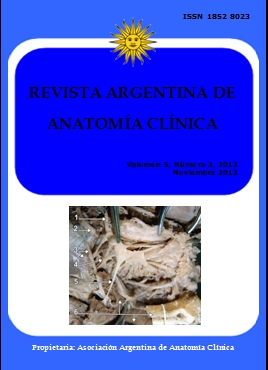AGE STRUCTURAL FEATURES OF VASCULAR WALL OF THE HUMAN WILLIS’ CIRCLE. Particularidades estructurales de la pared vascular del polígono de Willis humano en relación con la edad
DOI:
https://doi.org/10.31051/1852.8023.v5.n3.14076Palabras clave:
human brain, arteries, Willis’ circle, anatomy, hombre, cerebro, arterias, polígono de Willis, anatomíaResumen
Determinar las particularidades histológicas y morfo-métricas de la estructura de los vasos del círculo grande del cérebro (polígono de Willis) en el lugar de su bifurcación en personas de diferentes edades. Los vasos del polígono de Willis han sido investigados en 48 muestras de cerebro, sacados de los cadáveres humanos (0-65 años) y divididos en grupos de acuerdo a la edad según la clasificación de la Organización Mundial de la Salud, usando los métodos microscópicos y morfométricos. El factor hemodinámico, que lleva al deterioro del endotelio de los vasos en el lugar de la bifurcación de los vasos del polígono de Willis, sirve de mecanismo inicial en el surgimiento de los engrosamientos de la íntima, que luego se transforman en las placas ateroscleróticas, lo que se nota en las personas de 34 y 35 años de edad.
The aim of this investigation was to determine the histological and morphometric particularities of the brain greater circle (Willis’ circle) vessels structure in their bifurcation area in human beings at various age periods. The Willis’ circle vessels were studied microscopically and morphometrically in 48 samples of human brains taken from the corpses of subjects aged 0 to 65 years divided into age groups according the World Health Organization classification. The hemo-dynamic factor leading to the vascular endothelium damage in the bifurcation area of the Willis’ circle vessels was determined to be the trigger mechanism for intimal thickenings formation transforming to atherosclerotic plaques in future, being more evident in subjects aged 34-35 years.
Referencias
Bazowski P, Ladzi?ski P, Gamrot J, Rudnik A, Baron J. 1991. Aneurysms of the anterior communicating artery and anomalies of the anterior communicating artery part of the circle of Willis. Neurol Neurochir Pol 25: 485–90.
Campbell GJ, Eng P, Roach MR. 1981. Fenestrations in the internal elastic lamina at bifurcations of human cerebral arteries. Stroke 12: 489-96.
Hassler O. 1962. Physiological intima cushions in the large cerebral arteries of young individuals. Acta pathol. et microbiol. Scand. 55: 19-27.
Mitkovskaya NP, Dukor DM, Gerasimenok DS. 2008. Acute coronary syndrome with ischemic disturbance of brain. Medical journal 3: 13-16.
Motavkin PA, Chertok VM. 1980. Histophysiology of vascular mechanisms of cerebral blood circulation. Moscow: Medicine. 200 p.
Petrenko VM. 2009. Cushions or valves of coronary arteries. Medicine of ??I Century 14: 33-36.
Ross R. 1999. Atherosclerosis – an inflammatory disease. N. Engl. J. Med. 340: 115-26.
Shormanov SV, Yalcev AV, Shormanov IS, Kulikov SV. 2007. Polypoid cushions of arterial vessels and the role in control of regional blood circulation. Morphology 131: 44– 49.
Velican C, Velican D. 1976. Intimal thickening in developing coronary arteries and its relevance to arteriosclerotic involvement. Atherosclerosis 23: 345-55.
Wellnhofer E, Osman J, Kertzscher U, Affeld K, Fleck E, Goubergrits L. 2010. Flow simulation studies in coronary arteries—impact of side-branches. Atherosclerosis 213: 475-81.
Yefinov ??. 2008. Wall thickness of large human arteries as a micrometric biomarker of age changes of arterial system for definition age in forensic medical practice. Morphology 133: 46.
Descargas
Publicado
Número
Sección
Licencia
Los autores/as conservarán sus derechos de autor y garantizarán a la revista el derecho de primera publicación de su obra, el cuál estará simultáneamente sujeto a la Licencia de reconocimiento de Creative Commons que permite a terceros compartir la obra siempre que se indique su autor y su primera publicación en esta revista. Su utilización estará restringida a fines no comerciales.
Una vez aceptado el manuscrito para publicación, los autores deberán firmar la cesión de los derechos de impresión a la Asociación Argentina de Anatomía Clínica, a fin de poder editar, publicar y dar la mayor difusión al texto de la contribución.



